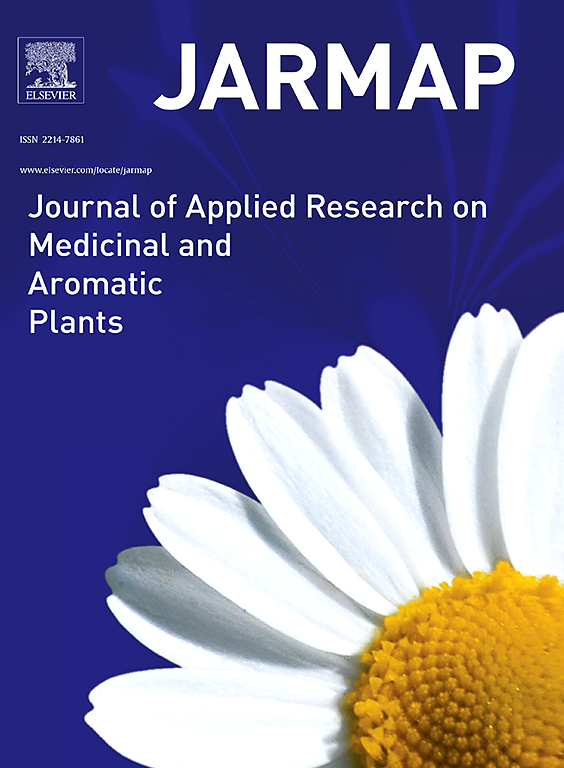Phenological growth stages of Dendrobium moniliforme (L.) Sw. according to the extended BBCH scale
IF 3.6
2区 农林科学
Q1 PLANT SCIENCES
Journal of Applied Research on Medicinal and Aromatic Plants
Pub Date : 2024-09-14
DOI:10.1016/j.jarmap.2024.100578
引用次数: 0
Abstract
Dendrobium moniliforme (L.) Sw. is a rare and endangered epiphyte plant of Orchidaceae with significant medicinal and ornamental value in China. It is necessary to use artificial cultivation to protect the wild resources because of its difficulty to survive in the wild. To date, more and more researchers have paid attention to the importance of phenology in stem development, flowering, pollination and fruiting of Dendrobium, but no specific and detailed phenological scale was set. Based on the extended BBCH scale, we used morphological and anatomical techniques to observe and record the growth and development characteristics of D. moniliforme. As a perennial herb, the growth process was divided into juvenile period and adult period. The juvenile period can be divided into two phases: seed germination (0) and seedling morphogenesis. Four stages are composed of the seedling morphogenesis, i.e. leaf development (1), formation of side shoots (2), stem (protocorm) elongation (3) and adventitious root formation (4). The adult period can be divided into vegetative growth and reproductive growth phases. Vegetative growth phases include bud development (0), leaf development (1), shoot development (3), root development (4) and dormancy (9). The reproductive growth phases include inflorescence emergence (5), flowering (6), development of fruit (7) and ripening of fruit and seed (8). For the entire growth and development process of D. moniliforme, 74 secondary growth stages were further coded and described. Additionally, the time series of different development stages in the annual growth cycle were discussed. This extended BBCH scale may provide guidance for the production and management practices of D. moniliforme.
根据扩展的 BBCH 标度计算的铁皮石斛(Dendrobium moniliforme (L.) Sw.的物候学生长阶段
铁皮石斛(Dendrobium moniliforme (L.) Sw.)是我国珍稀濒危的兰科附生植物,具有重要的药用和观赏价值。由于其难以在野外生存,因此有必要采用人工栽培的方式来保护野生资源。迄今为止,越来越多的研究者开始关注物候在铁皮石斛茎干发育、开花、授粉和结果中的重要性,但还没有制定具体详细的物候尺度。基于扩展的BBCH量表,我们利用形态学和解剖学技术观察和记录了铁皮石斛的生长发育特征。作为一种多年生草本植物,其生长过程分为幼苗期和成株期。幼苗期可分为种子萌发(0)和幼苗形态发生两个阶段。幼苗形态发生分为四个阶段,即叶片发育(1)、侧芽形成(2)、茎(原茎)伸长(3)和不定根形成(4)。成株期可分为无性生长期和生殖生长期。无性生长阶段包括芽的发育(0)、叶的发育(1)、嫩枝的发育(3)、根的发育(4)和休眠(9)。生殖生长阶段包括花序萌发(5)、开花(6)、果实发育(7)以及果实和种子成熟(8)。在 D. moniliforme 的整个生长发育过程中,有 74 个次生生长阶段被进一步编码和描述。此外,还讨论了年生长周期中不同生长阶段的时间序列。这一扩展的 BBCH 量表可为 D. moniliforme 的生产和管理实践提供指导。
本文章由计算机程序翻译,如有差异,请以英文原文为准。
求助全文
约1分钟内获得全文
求助全文
来源期刊

Journal of Applied Research on Medicinal and Aromatic Plants
Pharmacology, Toxicology and Pharmaceutics-Drug Discovery
CiteScore
6.40
自引率
7.70%
发文量
80
审稿时长
41 days
期刊介绍:
JARMAP is a peer reviewed and multidisciplinary communication platform, covering all aspects of the raw material supply chain of medicinal and aromatic plants. JARMAP aims to improve production of tailor made commodities by addressing the various requirements of manufacturers of herbal medicines, herbal teas, seasoning herbs, food and feed supplements and cosmetics. JARMAP covers research on genetic resources, breeding, wild-collection, domestication, propagation, cultivation, phytopathology and plant protection, mechanization, conservation, processing, quality assurance, analytics and economics. JARMAP publishes reviews, original research articles and short communications related to research.
 求助内容:
求助内容: 应助结果提醒方式:
应助结果提醒方式:


